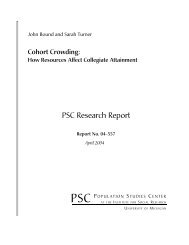Tracking metropolitan America into the 21st century - Population ...
Tracking metropolitan America into the 21st century - Population ...
Tracking metropolitan America into the 21st century - Population ...
Create successful ePaper yourself
Turn your PDF publications into a flip-book with our unique Google optimized e-Paper software.
analysis in one large region, New York,and compare <strong>the</strong> region’s attributesunder <strong>the</strong> old and new systems. We<strong>the</strong>n contrast demographic rankings of<strong>metropolitan</strong> areas using <strong>the</strong> MetroSAconcept to those provided by <strong>the</strong> oldMSAs and PMSAs.Local Choices and Changes—New YorkAs was <strong>the</strong> case under <strong>the</strong> old standards,<strong>the</strong> choice a user makes indefining a local area for study can significantlyaffect <strong>the</strong> results. For NewYork, <strong>the</strong>re are now three ways todefine <strong>the</strong> metro area, ra<strong>the</strong>r than two(Finding C). Table 6 compares populationsizes and socio-economic attributesfor <strong>the</strong> former New York CMSAand PMSA with <strong>the</strong> new CSA, MetroSA,and Metropolitan Division containingNew York City. The formerCMSA and <strong>the</strong> current CSA are similarin size, while <strong>the</strong> former PMSA issimilar to <strong>the</strong> current metro division.Interestingly, <strong>the</strong> current MetroSA,<strong>the</strong> geography likely to be used mostoften, has no parallel in <strong>the</strong> old standards.Whereas <strong>the</strong> former PMSAcomprised only 44 percent of <strong>the</strong>CMSA’s population, <strong>the</strong> current MetroSAaccounts for 86 percent of <strong>the</strong>CSA. Even <strong>the</strong> smaller geographicalunit, <strong>the</strong> division, makes up more thanhalf of its CSA’s population.It is not surprising <strong>the</strong>n, that <strong>the</strong>reare noticeable differences between <strong>the</strong>profile of <strong>the</strong> “new” New York (MetroSA)and <strong>the</strong> “old” New York(PMSA). The MetroSA is wealthier,whiter, more educated, and has ahigher percentage of its population inmarried-couple households. These differencesreflect <strong>the</strong> new area’s reach<strong>into</strong> <strong>the</strong> far suburbs of nor<strong>the</strong>rn andcentral New Jersey, Long Island, andeven eastern Pennsylvania. By far, <strong>the</strong>greatest disparity between <strong>the</strong> two<strong>metropolitan</strong> area definitions appearsin race and ethnicity attributes.The new MetroSA is majority non-Hispanic white (53 percent), while <strong>the</strong>old PMSA was only 40-percent white.National Changes—MetropolitanRankingsNew York presents one of <strong>the</strong> moreextreme examples of how <strong>the</strong> new classificationsystem may alter our understandingof who lives in particular<strong>metropolitan</strong> areas. But significantchanges are also evident in o<strong>the</strong>r partsof <strong>the</strong> nation, where new metro areaswere created, expanded, or combined.The demographic consequences of<strong>the</strong> new system are apparent across<strong>the</strong> nation’s largest metro areas, too.Table 7 presents rankings of old andnew metro areas (MSAs/PMSAs/NEC-MAs vs. MetroSAs) by population,income, and educational attributesusing Census 2000 data. One immediatelyapparent change is that New Yorkreplaces Los Angeles as <strong>the</strong> most populated<strong>metropolitan</strong> area in <strong>the</strong> country,with nearly 6 million more peoplethan its West Coast counterpart. Dallas,meanwhile, jumps from tenth tofifth, due to its combination with FortWorth. Although Detroit’s populationincreases slightly, its rank declinesfrom sixth to ninth. Miami makes it<strong>into</strong> <strong>the</strong> top ten (from twenty-fourth),thanks to its new grouping with FortLauderdale and West Palm Beach,while Atlanta just misses <strong>the</strong> top ten,falling to eleventh in rank.The new system also alters ra<strong>the</strong>rsignificantly <strong>the</strong> list of wealthiestmetro areas, as measured by <strong>the</strong> shareof households with annual incomeabove $75,000. Formerly, half of <strong>the</strong>top 12 metro areas were in <strong>the</strong> greaterNew York region, but since four of<strong>the</strong>se are now incorporated <strong>into</strong> <strong>the</strong>New York MetroSA, <strong>the</strong>y leave roomfor o<strong>the</strong>r metro areas to move up <strong>the</strong>list. Hartford and Anchorage, forinstance, now break <strong>into</strong> <strong>the</strong> top 15.Simultaneously, <strong>the</strong> combination offormer PMSAs <strong>into</strong> <strong>the</strong> New York-Nor<strong>the</strong>rn New Jersey-Long IslandMetroSA moved New York up in <strong>the</strong>wealth rankings from fifty-one totwelve.On <strong>the</strong> share of adults with at leasta bachelor’s degree, many collegetowns are among <strong>the</strong> highest-rankedmetro areas under both <strong>the</strong> old andnew systems, but some ordering didchange. The Ann Arbor MetroSAretained only <strong>the</strong> one county from itsold PMSA that contains <strong>the</strong> Universityof Michigan, elevating it from nineteenthto second in <strong>the</strong> ranking. IowaCity, meanwhile, added ano<strong>the</strong>rcounty outside <strong>the</strong> University of Iowa,dropping it from second to eighth.Likewise, Bloomington, IN, and Madison,WI, each added two counties to<strong>the</strong>ir <strong>metropolitan</strong> definitions, causing<strong>the</strong>m to fall out of <strong>the</strong> top 15. AndIthaca, NY, one of <strong>the</strong> 49 new <strong>metropolitan</strong>areas and home to CornellUniversity, now ranks third. Perhaps<strong>the</strong> most notable change in <strong>the</strong> educationalrankings is <strong>the</strong> drop San Franciscotakes from fourth to fourteenth,due to its combination with Oakland.In summary, <strong>the</strong>se examples demonstratethat <strong>the</strong> rules governing <strong>metropolitan</strong>area definitions may greatlyinfluence our understanding of whichregions are biggest, richest, or brightest.Discussion and ImplicationsThe real-world implications of<strong>the</strong> new <strong>metropolitan</strong> classificationsdiscussed here haveyet to be realized, in large partbecause many individuals and organizationsare still relying on <strong>the</strong> old (andin some cases, even earlier) definitionsin research and practice. Brookings’own studies that use Census 2000data still employ <strong>the</strong> older definitionsthat were in effect at <strong>the</strong> time of <strong>the</strong>census. The slow pace at which <strong>the</strong>new definitions are being put to usereflects in part OMB’s adoption ofnovel concepts like micropolitan statisticalareas, <strong>metropolitan</strong> divisions,and combined statistical areas. Revisionsduring <strong>the</strong> 1990s, by contrast,merely updated existing concepts withnew population data. In any case,whatever effects <strong>the</strong> new classificationshave, <strong>the</strong>y are likely to occur16November 2004 • The Brookings InstitutionThe Living Cities Census Series















